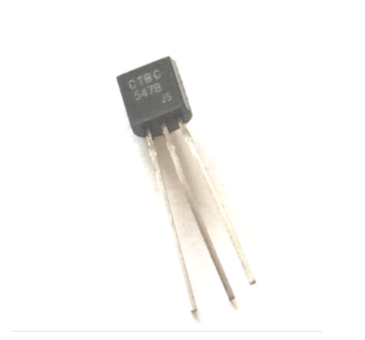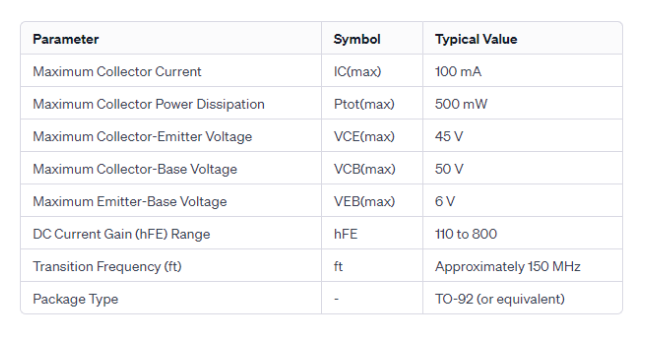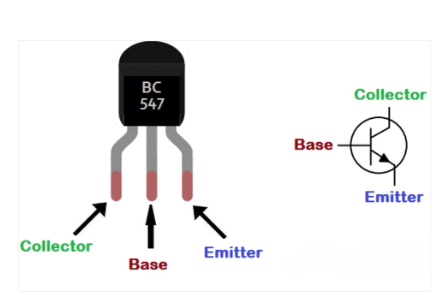gennaio 26, 2024
1598

The BC547 transistor is a versatile electronic component widely used in various circuits for signal amplification, switching, and other applications. This article explores the key specifications of the BC547, including its gain, current limits, and voltage characteristics. Additionally, it covers the pinout configuration, substitute transistors, and practical applications such as using the BC547 as a switch or in a water level indicator. Understanding these aspects is crucial for engineers, hobbyists, and students working with electronic circuits.

The BC547 transistor, with a gain value ranging from 110 to 800, plays a crucial role in amplifying signals. This gain value signifies the transistor's ability to magnify an input signal, emphasizing its amplification capacity. It is essential to note that the Collector pin can handle a maximum current of 100mA. Consequently, any connected loads should not exceed this limit to ensure proper functionality and prevent potential damage.
To bias the transistor correctly, a current must be supplied to the base pin, denoted as IB, which should be limited to 5mA. Biasing is a crucial step in transistor operation, as it ensures the device operates within its specified parameters.
When the BC547 transistor is fully biased, it enters the Saturation Region, allowing a maximum current of 100mA to flow between the collector and emitter. In this stage, the typical voltage across the Collector-Emitter (VCE) is approximately 200mV, and the Base-Emitter (VBE) voltage is around 900mV.
Conversely, when the base current is removed, the transistor transitions into the Cut-off Region, where it becomes fully off. During this stage, the Base-Emitter voltage is approximately 660mV.
The BC547 transistor features a standard pinout configuration with three pins, each serving a distinct purpose in the transistor's operation.

Collector (Pin 1):
Current flows into the transistor through the collector. The collector region is responsible for collecting charge carriers (electrons or holes) from the external circuit. It acts as the input terminal for current in the transistor.
Base (Pin 2):
The base pin plays a critical role in controlling the biasing of the transistor. Proper biasing is essential for ensuring the transistor operates within its specified parameters. By supplying a controlled current (IB) to the base, the transistor can be biased to allow or restrict the flow of current between the collector and emitter.
Emitter (Pin 3):
Current drains out through the emitter. The emitter is the output terminal of the transistor, from which the amplified current exits to the external circuit. It serves as the exit point for charge carriers collected by the collector.
Understanding the functions of each pin is crucial for correctly integrating the BC547 transistor into electronic circuits. The collector, base, and emitter together define the transistor's basic characteristics and modes of operation. Proper connections and biasing are vital for achieving the desired amplification and control in electronic applications using the BC547 transistor.
Substituting transistors is a common practice in electronics when a specific component is not available or when different performance characteristics are desired.
BC549:
BC549 is also an NPN bipolar junction transistor (BJT) with similar characteristics to BC547. It can be used as a direct substitute in many applications.
BC636 and BC639:
These are complementary PNP and NPN transistors, respectively. BC636 and BC639 can be used in place of BC547 and its complementary BC557, respectively, in many applications.
2N2222 TO-92 and 2N2222 TO-18:
2N2222 is a widely used NPN transistor available in both TO-92 and TO-18 packages. It is a versatile transistor suitable for various amplification applications. The TO-92 and TO-18 packages refer to the different physical packaging styles.
2N2369:
2N2369 is an NPN transistor commonly used in switching applications and low-power amplification. It can be considered as a substitute for BC547 in certain scenarios.
2N3055:
2N3055 is a power transistor commonly used for medium to high-power amplification and voltage regulation applications. It is not a direct substitute for BC547, as it serves different purposes and has different power handling capabilities.
2N3904 and 2N3906:
These are general-purpose NPN (2N3904) and PNP (2N3906) transistors frequently used in amplification and switching applications. They can be suitable substitutes for BC547 and BC557, respectively.
2SC5200:
2SC5200 is a high-power NPN transistor used in audio amplifier applications. It is not a direct substitute for BC547, as it is designed for higher power requirements.
When substituting transistors, it's crucial to check the datasheets for each component to ensure compatibility with the specific application and circuit requirements. While these transistors can often be used as substitutes, variations in electrical characteristics may exist, so careful consideration of the application is necessary.
Yes, the BC547 transistor can be used as a switch. The transistor operates in three main regions: active, saturation, and cut-off.
Active Region:
In the active region, the transistor amplifies the input signal. This is the region where it acts as an amplifier.
Saturation Region:
In the saturation region, the transistor is fully biased, allowing a maximum current to flow between the collector and emitter. This is the region where the transistor is essentially "on" and can be used as a switch to conduct current.
Cut-off Region:
In the cut-off region, the transistor is fully off, and no current flows between the collector and emitter. This is the region where the transistor acts as an open switch.
When using the BC547 as a switch, you typically operate it between the saturation and cut-off regions. In the saturation region, the transistor is "on," allowing a significant amount of current to flow through, and in the cut-off region, the transistor is "off," blocking the flow of current.
The BC547, being an NPN transistor, is often used in low-power switching applications, such as turning on and off small electronic devices or controlling the state of a signal in digital circuits.
BC547 transistor is a versatile component and finds applications in various electronic circuits.
Current Amplification:
The BC547, like many other transistors, is widely used for current amplification. By controlling the base current, it allows a larger current to flow between the collector and emitter, thus amplifying the input signal. This property makes it useful in audio amplifiers, signal processing circuits, and other applications requiring signal amplification.
Switching Applications:
The BC547 is frequently employed as a switch in electronic circuits. When used as a switch, it transitions between the saturation and cut-off regions. In the saturation region, the transistor is fully "on," allowing a significant current flow, while in the cut-off region, it is fully "off," blocking the current. This switching capability makes it suitable for controlling various electronic devices, such as relays, LEDs, and small motors.
Pulse Width Modulation (PWM):
The BC547 can be used in pulse-width modulation circuits. PWM is a technique where the average power delivered by a signal is varied by changing its duty cycle. This is commonly employed in applications like motor speed control, dimming of LEDs, and generating variable analog signals from digital sources.
Motor Speed Control:
As mentioned, the BC547 can be utilized for controlling the speed of a motor. By modulating the transistor's operation using PWM, you can control the power supplied to the motor, thereby adjusting its speed. This is particularly useful in robotics, automation, and other applications where precise control of motor speed is required.
Audio Amplification:
Due to its ability to amplify small signals, the BC547 can be used in audio amplifiers. It can be part of pre-amplification stages in audio circuits, enhancing the strength of the audio signal before it goes to the power amplifier.
Signal Conditioning:
BC547 transistors are employed in signal conditioning circuits where the characteristics of signals need to be modified or adjusted. This can include amplification, filtering, and shaping of signals for further processing.
Digital Logic Circuits:
BC547, being a general-purpose NPN transistor, can be used in digital logic circuits for signal inversion, buffering, or level shifting.
The beta value, also known as hFE or the current gain, of a BC547 transistor typically falls within a range of 110 to 800. This value represents the ratio of the collector current (IC) to the base current (IB) in a bipolar junction transistor (BJT).
The beta value is an important parameter as it indicates the transistor's amplification capability. A higher beta value means that the transistor can provide more current amplification, making it more effective in amplifying weak signals.
Collector−Emitter Voltage (VCE): Typically around 45-50V.
Collector-Base Voltage (VCB): Typically around 50V.
These values represent the maximum voltage that can be applied across the respective terminals without causing breakdown in the transistor.
It's crucial to consult the datasheet of the specific BC547 transistor model you are using, as these values can vary slightly among different manufacturers and production batches.
The BC547 transistor is commonly used in water level indicator circuits due to its characteristics that make it suitable for switching applications and simple sensor designs. In a water level indicator circuit, the BC547 is often employed as a switch to detect the presence or absence of water at different levels.
Switching Ability
The BC547 can operate as a switch, transitioning between saturation and cut-off regions based on the input signal at its base. In a water level indicator, the presence or absence of water at different levels is used to turn the transistor "on" or "off," effectively acting as a switch.
Low Power Requirement
BC547 is a low-power transistor, making it suitable for applications where power consumption is a concern. In water level indicators, low power consumption is desirable for efficient operation and longer battery life in portable devices.
Ease of Use
BC547 is readily available and relatively inexpensive, making it a practical choice for simple electronic projects, including water level indicators. Its widespread use in educational settings and hobbyist projects contributes to its popularity.
Versatility
The BC547 can be easily configured in various circuit designs. In a water level indicator, the transistor can be part of a simple switching circuit that activates an indicator (such as an LED) when water reaches a certain level.
Reliability
BC547 transistors are known for their reliability and stability in switching applications. This is important in water level indicators, where the reliable detection of water levels is critical.
In the described water level indicator circuit, the transistor's base makes contact with the water at different levels, completing the circuit and allowing current to flow from the base to the emitter. This current flow indicates the presence of water at a specific level, activating the corresponding part of the indicator circuit.
The BC547 is an NPN (Negative-Positive-Negative) bipolar junction transistor (BJT). In the context of transistors, NPN and PNP (Positive-Negative-Positive) refer to the arrangement of the layers of semiconductor material within the transistor.
In an NPN transistor like the BC547:
N-Type Semiconductor: The layer closest to the collector terminal is made of N-type semiconductor material, where electrons are the majority charge carriers.
P-Type Semiconductor: The middle layer is made of P-type semiconductor material, where "holes" (absence of electrons) are the majority charge carriers.
N-Type Semiconductor: The layer closest to the emitter terminal is made of N-type semiconductor material.
In contrast, a PNP transistor has a reversed arrangement of semiconductor layers:
P-Type Semiconductor: The layer closest to the collector terminal is made of P-type semiconductor material.
N-Type Semiconductor: The middle layer is made of N-type semiconductor material.
P-Type Semiconductor: The layer closest to the emitter terminal is made of P-type semiconductor material.
The BC547 being an NPN transistor is commonly used for amplification, switching, and signal processing applications in electronic circuits. It's important to note the transistor type (NPN or PNP) when incorporating it into a circuit, as the polarity of the transistor determines its behavior and how it should be biased for proper operation.
The 2N2222 and BC547 are both NPN transistors, yet they differ in key electrical characteristics. The 2N2222 exhibits higher collector-base voltage (60V), collector-emitter voltage (30V), and maximum collector current (800mA) compared to the BC547 with respective values of 50V, 45V, and 100mA. These distinctions make the 2N2222 more suitable for applications with higher voltage requirements and larger current loads, while the BC547 may be preferred in circuits with lower voltage and current demands.
BC547 transistor stands as a fundamental building block in electronic design, offering amplification capabilities, switching functionality, and reliability. Its specifications, pinout configuration, and various applications, including its role in water level indicators and PWM circuits, showcase its versatility. Engineers and electronics enthusiasts can leverage the BC547 and its substitutes judiciously in diverse projects, ensuring proper biasing, connections, and understanding of its operational regions.